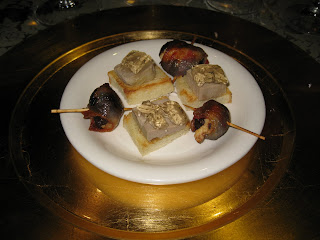
 The tricky part is making the biscotti in various lengths, so that when stacked {longest at the bottom} a tree shape is formed. There are 3 biscotti in a layer arranged in the form of a triangle. Each layer is rotated 90 degrees... fun!
The tricky part is making the biscotti in various lengths, so that when stacked {longest at the bottom} a tree shape is formed. There are 3 biscotti in a layer arranged in the form of a triangle. Each layer is rotated 90 degrees... fun!I love cooking and entertaining, but I often lose track of my recipes I've tried and like... I need some place to keep track of the recipes, the changes I made, and how the dish worked out. Blogger seems to work very well for this sort of thing.

 The tricky part is making the biscotti in various lengths, so that when stacked {longest at the bottom} a tree shape is formed. There are 3 biscotti in a layer arranged in the form of a triangle. Each layer is rotated 90 degrees... fun!
The tricky part is making the biscotti in various lengths, so that when stacked {longest at the bottom} a tree shape is formed. There are 3 biscotti in a layer arranged in the form of a triangle. Each layer is rotated 90 degrees... fun!






 The Fonseca tasted different than the other ports with a greenish, minty flavor. Very nice, but just different.
The Fonseca tasted different than the other ports with a greenish, minty flavor. Very nice, but just different.







Honey Mousse
It was a very fun evening, and it was very interesting to see how different dishes paired with the wines. Each wine had at least one dish where the wine was enhanced because of the flavor components of the recipe. Conversely, each dish had a wine that really raised the dish from good to excellent.
See more photos and video from the dinner Here!
My wine and food comments follow:
1976 Rieussec: Darkest in color, golden with a little browning.Great nose of honey and apricots, good acid, flavors same as nose, very concentrated, heaviest wine in the mouth. This wine went great with the Roquefort Terrine and Apple salad. The strong cheese needed the power of the Rieussecs to stand up to it.
1979 Chateau De Rayne Vigneau: light golden color, lighter in the mouth, very good acid, finish lighter, more Alc? interesting flavors more on the lemony side. {later found out this one is 14.5% Alc.} This wine was great with the Duck mousse. Seemed that the higher acid cut the taste of the duck fat and made for a great combination. Probably the best sipping Sauternes due to the higher acid level.
1984 Rieussec: very similar to the 1976 not as dark in color, fresher than the 76. Has the great honey, apricot nose...also some interesting bramble character to it that enhances the flavors rather than detracts. Like the 76 this wine went great with the Roquefort Terrine. Also the Bacon wrapped figs stuffed with goat cheese went great.
1986 Chateau Lafaurie Peyraguey: Golden in color, but being the youngest wine, a little darker than would be expected. e.g. the 1979 was lighter in color. Has a toasty component to the nose, good acid, perhaps a little sharp. Later in the evening the nose developed a cedar, wood character... {We spent a lot of words trying to describe the nose and flavor....} This wine did the best of all the Sauternes with the Sweet and Hot Habanero Pork. I think it cut the hotness of the pork the best with a heavy thick viscosity to the wine.
Doris Wine notes
’76 Rieussec: Honey caramel nose; luscious thick texture, Great with the foie gras, the terrine, and the pork.
1979 Chateau De Rayne Vigneau: Not much in the nose; very nice in mouth with good acid. Much lighter in body and taste than others. I thought it would be better with food because of the lively acidity, but this was true only with the lightest dishes. It did not stand up to the Roquefort, the pork or the mousse.
1984 Rieussec: Heavy honey nose, very rich; still has acid balance
1986 Chateau Lafaurie- Peyraguey: Honey and tea nose with some butterscotch. Toasty, complex flavors with some earthy, barn yard elements. The habenero pork and sweet potato mash dish transformed this wine! It lost all the earthy heavy notes and became a full rich wonderful Sauternes.
Comments on the Menu:
Foie Gras Toasts with Sauternes Geleé: We used Duck Mousse instead of Foie Gras as Foie Gras is Tres' Cher and also has it's dark side..... But the Duck Mousse was wonderful. The Sauternes Gelee' added some sweetness and lightness to the flavors that was a great combination!!! My favorite dish of the evening. The wine we used for the Gelee' was a Pozzen late harvest semillon called Maitresse @ $19/tenth at Bevmo: Doris' comments:
Doris' comments:
We used Challah bread for the toasts, which has a Brioche texture and a buttery flavor.
The quality of the Pate made a big difference. This one from Draegers was all duck liver mousse terrine—with no pork or chicken and had a rich but mild flavor. (We later tried a Three Pigs brand from Andronicos—which had some pork, but it was not nearly as good and very far away from ‘foie gras’. The pork flavor dominated and changed the effect completely.)
The flavor of the Gelee is just the essence of the wine used; use as good a wine as conscience allows. And we did save $80 by not using actual Foie Gras so we could splurge here.
This went really well with all of the wines. Yum!
Stuffed fig recipe from “Aperitif, recipes for Simple Pleasures in the French Style” by Georgeanne Brennan.
Dried figs such as Mission
Goat Cheese
Thin bacon cut into pieces
Choose figs that are supple and still retain some natural shape. Make a lengthwise slit in each fig and press in about a teaspoon of goat cheese. Wrap a 2-3” piece of bacon around the fig and secure with a toothpick. The length of the bacon piece depends on the size of the fig, but you need a bit of an overlap to hold everything together when it cooks. Broil, turning once, just until the bacon is browned and barely crisped. Serve hot or warm.
I thought that the tangy goat cheese and salty bacon would do more for the wines. It was just O.K.
Roquefort Walnut Terrine with Apple Salad: We modified the recipe as follows. Doris made the cream fraiche used in the recipe, We used granny smith apples and Doris modified the vinaigrette slightly using less mustard than called for. Very good dish. There was lots left over and that was a good thing! We enjoyed it for days after.
Doris' comments:
1. I was worried that the terrine would not stay together, so made a thick crème fraiche (4 tablespoons of plain yogurt per cup of whipping cream; cultured overnight in a yogurt maker). We also used a smaller loaf pan: 4 X 8 and chilled overnight.
2. The recipe proportion of 2 tablespoons of Dijon mustard to 1 tablespoon of balsamic vinegar and ¼ cup of olive oil seemed like too much mustard. I also wanted more quantity for 4 apples and additional elements to compliment the wines. So the mustard was cut to 1.5 Tablespoons, the oil was increased with a blend of olive and walnut oils, and the vinegar amount was increased with strawberry balsamic and an appley champagne vinegar.
3.Other than that, yes we followed the recipe.
The combination of the terrine and the apple salad was great and wonderful with the wines, especially with the Riessacs.
Sweet and Hot Habanero Pork: Followed the recipe for the Pork and sauce...I would add some thickener to the sauce next time. The sweet potato mash was a side we picked for a sweet component to the recipe and I think it went well.
Doris' Comments: Amazingly this dish worked with the wines, even improving one of the earthier ones by somehow smoothing out all of its edgier notes. The contrast was really interesting. The sweet potato mash was a necessary addition to the original dish.
Honey Mousse: While good, this is the dish that I was most disappointed with.... The great honey flavors I tasted when cooking it were lost in all the whipped cream. Next time I would use half the cream and double the honey. I might have to add more gelatin to get it to set? We also wanted some additional flavor components for this dish, so Doris made lemon Madelaines, carmel branches, and apricots stuffed with almonds, and we served candied ginger as well.
Doris's comments:
Lemon Madeleines
I used the recipe for Coupelles, Langues de Chats, from Julia Child’s “Mastering the Art of French Cooking, Volume II”. George originally voted for cookie cups, but they would not crisp up or alternatively crisped but grew sadly limp within an hour. I think they were a victim of winter humidity. Happily, the remaining dough made fairly good mini madeleines.
Caramel Sugar Sticks
Winter humidity complicates caramel making too. It solidifies too quickly in the pan, yet the finished sticks remain just a bit too soft and sticky. Used a recipe in Charlie Palmer’s “Great American Food”.
Candied Lemon Zest
Used a recipe in Charlie Palmer’s “Great American Food”.
Apricots
Used whole dried apricots. Enlarged the seed slit and soaked apricots in late harvest Riesling for 6 hours. Drained and stuffed with 3 or 4 slivers of blanched toasted almonds. While the recipe suggested that if the apricots were soaked for more than 6 hours, they would get soggy, I don’t think that was nearly enough time to absorb any wine flavor.
I expected the honey mousse to be an incredible match, but it was a little too subtle for the heavier Sauternes and didn’t live up to the memory of a 1970’s Chez Panisse Honey Comb mousse with ’59 Suideraut dessert. Too late I thought that I should have brought out more honey to drizzle. The smaller accompaniments were meant to match with individual notes in the wines and they did more less.
-----~~~ ------
demolishing** Here's the story behind our use of "demolishing some wine..."
On some vacation in the 80s, feeling good from tasting wine all day, we were joking about people putting a bottle of Champagne in the freezer for a rapid chill and forgetting about it...."It would be like a UCB {Unexploded Champagne Bottle} ... and hence the need for a "Champagne Disposal Squad". So we began to use "demolition" to describe the need to drink or deal with a wine situation , e g.. like having some old wine that may be in danger of going bad...
Rob, Wendy, Glen, and Sylvie, : please add some comments about the dinner!

I used a recipe that had a herb rub to marriate the roast for a day prior to cooking.
Cooking:
Let the Roast stand at room temp for at least 2 hrs
Preheat oven to 450
Place meat in a shallow roasting pan fat side up.
Roast 15 mins.
Reduce the temp to 350 and roast for @ 20-23 min per lb until the thermometer inserted in the middle of the roast registers 125 for medium rare.
Let the roast rest for 15-20 minutes before carving.

My roast was in the over at 1:00 and it was done at 4:00... so 180min for 9-3/4 lbs or about 18 minutes per lb. As I said I think the reduced time was due to cutting the rib bones away from the roast.
The roast was very tender and had great flavor. A big hit!




